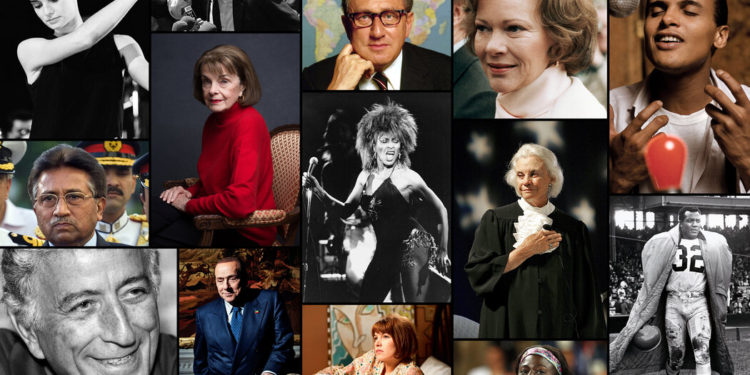By THE NEW YORK TIMES
In February 1961, The New York Times, citing a study by the American Medical Association, ran a brief article reporting that Americans could very well enjoy a life expectancy of 120 years during the 21st century.
The A.M.A., reflecting a now bygone era perhaps more optimistic than our own, was foreseeing a continuing tide of advances in medical science that would carry people along in good health for decade after decade.
Suffice it to say that the 21st century still has a long way to go before anyone looking back from the 22nd will be able to confirm whether those medical authorities of yore were right. Who knows, after all, what life-preserving medical breakthroughs the next 76 years may have in store?
But from where we sit now, the good doctors from 1961 seem to have been wildly off base. Life expectancy trends for many Americans — the average now stands at 77.28 — are going in the opposite direction.
And yet if you perused a lot of obituaries over the last year, particularly about the more towering figures who left us, you might be forgiven for thinking that people, on the whole, must be living into riper and riper old age — pushing 100 if not waltzing beyond it.
Not so long ago we saw, in brisk succession, three national figures who were born during the Roaring Twenties die in the midst of whatever history will call the ’20s we’re living through now.
Rosalynn Carter, who was remembered as the most politically engaged first lady since Eleanor Roosevelt, died at 96, leaving behind her 99-year-old husband, Jimmy, who is assured of being the longest-living American president when his time comes.
In July, Henry Kissinger was hale enough at 100 to fly to Beijing, the scene of one of his most historic diplomatic breakthroughs, President Richard M. Nixon’s opening to China. He shook hands with Xi Jinping, just as he had with Mao Zedong in 1972. A little more than four months later he was gone, as polarizing in death as he had been in life, remembered on the one hand as a brilliant believer in realpolitik and on the other as a Cold War tactician who could countenance, in the name of asserting American power, the all-too-real carpet bombing of Cambodia, not to mention spasms of human rights abuses around the world.
And then Sandra Day O’Connor, afflicted by dementia, slipped away at 93, enshrined in history as the first woman to ascend to the United States Supreme Court.
Throughout the year, distinguished names from all walks of life were in their 10th decade, or even their 11th, when the end came. Norman Lear, who introduced sitcoms to the real world, was 101 (and he wasn’t done yet; he left behind a pile of uncompleted projects on his desk). Françoise Gilot, the artist remembered as the one disillusioned lover of Picasso who had the will to walk out on him, was also 101, dying less than three months before the death of her 76-year-old son, Claude Ruiz-Picasso, who had watched over his father’s estate. Al Jaffee, a cartoonist beloved by generations of Mad magazine readers, was 102. John B. Goodenough, who shared a Nobel Prize for giving us the rechargeable lithium battery, was 100.
Nonagenarians Aplenty
A host of the distinguished made it to 99: Bob Barker, the seemingly ageless game show host; Charles T. Munger, Warren Buffett’s billionaire right-hand man; Menaham Pressler, the tireless classical pianist and co-founder of the Beaux Arts Trio; former Senator James L. Buckley of New York, a blue-blooded blue-state conservative and brother of William F.; the paradigm-shifting, Nobel-winning economist Robert M. Solow; and the lyricist Sheldon Harnick, who had grasped his own mortality as a far younger man when, in a song from “Fiddler on the Roof,” he could lament, “Sunrise, sunset/Swiftly flow the days.”
Others’ years were almost as long. Bob Richards, the Olympian pole-vaulter who landed on boxes of Wheaties in the 1950s, was 97. Frank Borman, who soared even higher in 1968, into lunar orbit, was 95, an age matched by Mangosuthu Buthelezi, the Zulu nationalist and rival to Nelson Mandela in apartheid South Africa, and Gina Lollobrigida, the actress and Italian sex symbol in both Europe and Hollywood. Another Nobel winner, Paul Berg, a father of genetic engineering, was 96.
Milan Kundera, the Czech novelist who found absurd humor in the drab oppression of the Soviet era, was 94, as was Mohamed al-Fayed, the Egyptian-born tycoon who died only weeks before he re-emerged in the public’s consciousness, this time through an actor playing him in the final season of the Netflix series “The Crown” as it revisited the tragically doomed relationship of his son Dodi and Diana, Princess of Wales.
Pat Robertson, the TV minister and religious empire-builder who salted his preaching with archconservative politics, was 93. And Dianne Feinstein, at 90 a junior member of this enduring cohort, still held her seat in the Senate when she died in her Washington home, having left her heart, to be sure, in San Francisco.
Yes, that’s a reference to the song, and it’s a reminder of how many music giants fell like ancient California redwoods in 2023, none more resoundingly than Tony Bennett. He didn’t just make it to 13 days shy of 97; he practically sang his way off the stage, performing well into his 10th decade before bowing out in the same Manhattan apartment he called home for most of his adult life. (As for him, he may have yearned for San Francisco in song, but his heart was always in New York.)
Less than three months earlier, Harry Belafonte succumbed at 96, having poured his soul into chart-climbing Caribbean songs, magnetic movie performances and a lifelong crusade for civil rights. He followed by less than three months the death, at 94, of Burt Bacharach, who left behind a rich catalog of sophisticated songs that ring of a different, glossier side of the raucous, rockish 1960s — tunes that will no doubt still be in the air in the 2060s.
In Music, the Bells Tolled
The music world, indeed, lost a pantheon of heroes. A host of them had careers spanning decades but were nonetheless remembered mostly as echoes of two in particular, the 1960s and ’70s: the virtuoso electric guitarist Jeff Beck; the songwriting folk troubadour Gordon Lightfoot; Robbie Robertson, the Canadian leader of the Band, who infused rock with a wholly original vein of Americana; and David Crosby, the singer, songwriter and guitarist whose name was almost inextricably tied with an ampersand to three bandmates: Stills, Nash and Young.
The dynamic Tina Turner emerged from the back roads of Tennessee in the late 1950s, shimmying as she sang, but it wasn’t until 1984, when she was in her mid-40s, that she reached pop music’s stratosphere with a string of monster hits. Jimmy Buffett, by contrast, was a comparative late bloomer, emerging in 1977, in his case from some boozy, laid-back imaginary hideaway called “Margaritaville.”
Sinead O’Connor was anything but laid-back, and when she died in London at 56, the cause unexplained, she summoned memories of a voice by turns breathy and powerful, of a persona defiant in her political stands, and of a life bruised by tragedy and depression.
Lisa Marie Presley, dead at 54, knew heartache as well, and though she had carved out a singing career of her own, it was fated always to remain in the shadow of her father’s.
There were deaths in the family — music families: Anita Pointer of the hitmaking Pointer Sisters and Rudolph Isley of the R&B stalwarts the Isley Brothers. Jazz lost the iconoclastic pianist Ahmad Jamal and the innovative saxophonist and composer Wayne Shorter, who rose from bebop to push the boundaries of the genre, defying purists by delving into rock-inflected fusion and the avant-garde.
And besides Mr. Pressler, classical music lost, among many others, another admired pianist, Andre Watts, who, as his obituary said, had become “one of the first Black superstars” in that world.
The acting trade mourned the deaths of three stars of sitcoms whose comic situations spun on for year after year without getting stale to their millions of fans: Suzanne Somers, from “Three’s Company” (two straight young women and a guy pretending to be gay rent a house from a prude of a landlord), Cindy Williams, Shirley on “Laverne & Shirley” (two young women work in a Milwaukee brewery in the 1950s); and the ultimately troubled Matthew Perry, from “Friends” (young pals, male and female, make their way in life together in New York City).
Ms. Lollobrigida wasn’t the only sex symbol to die this year: Raquel Welch, who was 82, was remembered, perhaps too much, for wearing a torn doeskin bikini in the nonsensical 1966 movie “One Million Years B.C.,” and perhaps not enough for her comic touch and her later successes on Broadway and as a businesswoman purveying a health and beauty program.
No one ever doubted Glenda Jackson’s seriousness, of course, as she sandwiched a career in Britain’s Parliament between an Oscar-winning run in films and, at 80, a return to the stage as a fearsome female King Lear. Michael Gambon was of the same ilk: for years an acclaimed dramatic presence in films and on stages in London and New York — although it’s unclear how many wide-eyed young devotees of the “Harry Potter” movies knew that about him when he died at 82; they may have known him only as the kindly wizardly headmaster Dumbledore.
Just as whimsical, or even more so, was the character Paul Reubens morphed into: Pee-wee Herman, a bow-tied, fun-loving man-child who tickled children on TV and even had their parents watching, if a bit bemusedly.
And speaking of over-the-top characters, let’s not forget Dame Edna Everage, Possums, “that divine doyenne of divadom,” as Margalit Fox wrote in her Times obituary about Barry Humphries, who brought Dame Edna “to delirious, dotty, disdainful Dadaist life.”
Whimsy was also the domain of the Colombian painter and sculptor Fernando Botero, whose signature was a race of voluptuously bloated figures — denizens, from priests to bullfighters, of an almost cartoonish world that, to him, had to do not with corpulence but with the sensuality of human life.
Literary Losses
If Mr. Kundera found dark humor in the Soviet bloc, Martin Amis found a bleak variety of it in the money-mad London of the 1980s and ’90s, as he reinvigorated a British literary scene for bookish crowds on both sides of the Atlantic and beyond. Cormac McCarthy did something of the same with American fiction, finding bleakness pretty much minus the humor in tales set in Appalachia and the Southwest, all while drawing prizes, movie adaptations and a legion of devoted readers.
Mr. McCarthy never received the Nobel Prize in Literature that some felt he deserved, but the novelist and essayist Kenzaburo Oe did, in 1994, for a body of work that evoked the carnage and atomic horrors of World War II while challenging what he saw as a dangerously reviving militarism in his country, modern Japan.
The American Louise Glück, too, took home a Nobel, in 2020, hers for volumes of personal poetry notable in part for how widely it was read. She wrote of loss, trauma and mortality but also of beauty and joy. She may have been talking about her own literary gift when she wrote, “from the center of my life came/a great fountain.”
And Khaled Khalifa, an important writer in contemporary Arabic literature, was dead at 59, bringing a premature halt to his politically pointed fiction after he had reached readers far beyond his native Syria through translations in a multiplicity of languages, from English to Chinese.
Our literary guides show us the complexity of life, but Jim Brown fairly embodied it: He was one of the greatest players in the history of American football, a Hall of Fame running back who combined power, agility and speed, sometimes dragging defenders with him into the end zone. He abruptly quit the game for a Hollywood career as an action hero. And he championed civil rights at a time, the 1960s, when it could be risky for Black athletes to challenge the status quo. It was an impressive legacy, but then came accusations that he’d been violent toward women, leaving all that he had accomplished tarnished.
Bobby Knight was another complicated sports figure: a brilliant, principled, immensely successful college basketball coach at Indiana who was known as much for his profane courtside rants, one punctuated by a flying folding chair flung across the court.
Willis Reed died with no such baggage. To New Yorkers, and Knicks fans in particular, he took with him the lasting image of a beloved warrior, a Hall of Fame center who shook off debilitating injury to emerge from a tunnel at Madison Square Garden in 1970 and limp into history, inspiring his team to a Game 7 championship victory.
In a later era, and on a track rather than on a court, Torie Bowe sprinted into history, she as an Olympic gold medal winner and a world champion, only to be stopped cruelly short, dying of complications of childbirth at 32.
The food we eat, it’s fair to say, has become more international in flavor, and credit for that can be given in part to four cooking authorities who died this year: Cruz Miguel Ortíz Cuadra, who championed Puerto Rican cuisine; Raghavan Iyer, Indian; Eileen Yin-Fei Lo, Chinese; and Emily Meggett, Gullah Geechee of the coastal Southeast.
In another part of the world, Silvio Berlusconi left the stage he had long occupied as a kind of one-man show in Italian life: a pioneering television kingpin, a brash, divisive prime minister and a veritable Trevi Fountain of scandal and prosecutions for corruption. And in the United Arab Emirates, Pervez Musharraf, the former president of Pakistan, died in exile, a military man and authoritarian at heart who was prized by Washington as an ally after 9/11 but who was later vilified at home precisely for those ties.
Chapters of History
Some deaths evoked dark times. The anarchist Ted Kaczynski, a.k.a. the Unabomber, killed three people and injured 23 others with homemade bombs in an anarchist’s crime spree that led the authorities on a 17-year manhunt. And Carolyn Bryant Donham was the young wife whose disputed accusation that Emmett Till had accosted her in a Mississippi general store in 1955 led to one of the country’s most heinous racial murders and, in response, a swelling cry for racial justice across the land.
There were deaths that had us remembering recent history’s odds and ends. The well-connected lawyer Harry Whittington would have probably never been a headline name had he not gotten in the way of a blast of birdshot fired by Vice President Dick Cheney on a Texas hunting trip in 2006. Though peppered with wounds, he was the one who immediately apologized.
Newton Minow, a Federal Communications Commission chairman, gained a measure of immortality in 1961 with three words, “a vast wasteland,” his description of America’s television landscape then. A national debate ensued.
Samuel Wurzelbacher had his unlikely run at celebrityhood when Senator John McCain, running for president in 2008, christened him “Joe the Plumber,” the personification of middle-class Middle America, after Mr. Wurzelbacher had an on-camera face-off with Mr. McCain’s opponent, Barack Obama, on a suburban Ohio street.
The deaths of Daniel Ellsberg and David Harris took us back to the home-front turmoil over the Vietnam War. Mr. Harris, a powerful voice of the antiwar movement, urged young men to resist the draft, as he did — a decision that landed him in jail while he was married to the folk singer Joan Baez. You’ll be cannon fodder, he warned them, sacrificed in a wasteful war.
It was a conclusion that Mr. Ellsberg largely confirmed when he leaked a secret government history of the war known as the Pentagon Papers and set in motion a landmark First Amendment battle in the Supreme Court over their publication in The Times and The Washington Post.
Still other deaths revived stories of yet another, ever more distant conflict, World War II, its surviving participants now a fast-dwindling band of brothers and sisters.
There was Ken Potts, the oldest known American survivor of Pearl Harbor, dead at 102. There was Guy Stern, 101, who escaped Nazi Germany as a Jewish teenager only to return to it as part of an Army intelligence unit, his mission to interrogate prisoners who might have sent him to a death camp as a youth had he not fled.
Traute LaFrenz also hailed from Germany, where she joined the White Rose, a resistance movement that dared to defy Hitler even at the cost of beheading. Living in South Carolina since the 1990s, she was the group’s last survivor at 103.
And there was Benjamin Ferencz, the last remaining former prosecutor of Nazi Germany’s war criminals. He was an infant when his family fled to America in the 1920s, escaping a pogrom of Jews in Transylvania. He grew up to join the Normandy invasion and to fight across France and into Germany to help bring an end to the war. After his service before the international war-crimes tribunal at Nuremberg, he devoted much of his life to crusading for international laws that would end wars of aggression.
Mr. Ferencz died at 103 holding on to that hope, though it must have been a fragile one by then. He, like those others who were born in the wake of one world war and who survived another, died as war again raged in Europe.







Discussion about this post